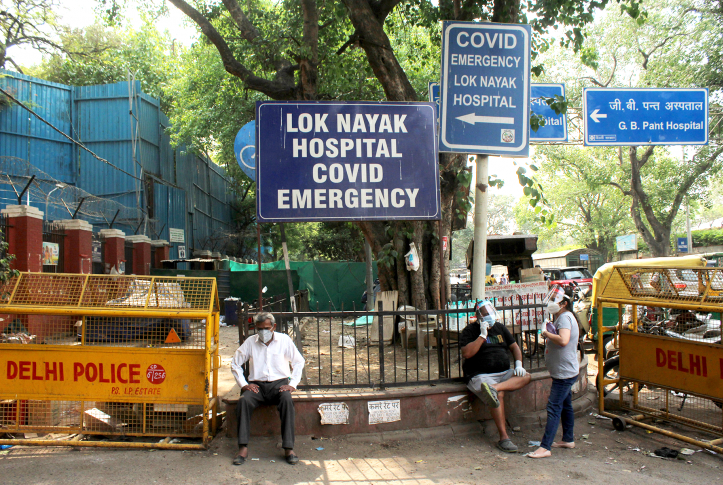India is in the throes of the world’s worst COVID-19 crisis — the official daily case count is now more than 350,000, breaking the world record for eight days straight. More than 3,000 people are dying each day; experts are concerned that the actual death count could be five times higher.
Photos of bodies burning on mass funeral pyres, stories about hospitals packed beyond capacity, and desperate pleas on social media for oxygen and medical supplies have drawn international attention to India’s dire situation; the United States and other countries have pledged aid. India’s woefully lax response to the second wave and its already anemic health care infrastructure are the primary drivers of the current surge.
What Explains the Surge?
Laxity Around Public Health Measures
India’s national lockdown in March 2020 was one of the strictest in the world. This initial response was in stark contrast to slack responses in the U.S., Brazil, and Sweden.
After a first wave of COVID-19 cases last fall, India appeared to have beaten back the virus. Until March 2021, the country was recording barely 13,000 new cases a day, less than Germany or France and among a population 18 times larger. Prime Minister Narendra Modi declared victory over the virus and allowed the country to return to business as usual, despite signs of trouble and warnings from public health officials. This resulted in election rallies drawing huge, unmasked crowds, and a religious festival in early April that attracted between 1 million and 3 million people to the banks of the river Ganges, now dubbed a superspreader event.
As officials created a false sense of security, mask-wearing and social distancing plummeted.
One Indian journalist said, “as a country and as a state, we declared victory too soon, we were complacent, we were callous, we were ignorant, and we were casual.”
Although the federal government in recent days has recognized the severity of the crisis, it is still reluctant to impose a national lockdown and is leaving it to states to impose restrictions. This delegation of authority is similar to one in the U.S., where rolling waves of the virus swept states when governors lifted lockdown measures prematurely.
Deadly Variants and Short Supply of Vaccines
Complicating matters is an insidious new variant of the virus, which appears to be more contagious and more lethal; some believe this is now the dominant strain in the hardest-hit parts of the country. Little is known about this variant, known as the “double mutant” because it contains genetic mutations found in two other versions that are difficult to control. Regardless of whether this variant is driving the surge, India does not have the capacity to identify and control emerging variants. Ideally, the country should be genomic sequencing 5 percent to 10 percent of all infections, but it is doing so for less than 1 percent of them.
Then, there’s an acute vaccine shortage. Although India is the world’s leading vaccine manufacturer, supply isn’t enough to rapidly vaccinate the country’s 1.36 billion people. As of April 28, less than 10 percent of the population had received even one dose.
The government’s vaccine policy is also sorely lacking; it reflects a failure of leadership to manage the crisis. By mid-February, the government had ordered barely enough doses to protect 3 percent of the population. In April, the government curtailed exports of COVID-19 vaccines — which it had been giving away — but there still aren’t enough doses. On May 1, vaccinations will be open to anyone over age 18, but supply remains inadequate, and many states are postponing this plan. Manufacturers have noted that export controls on needed ingredients have stymied their ability to ramp up production.
Lack of Health System Preparedness
The Indian health care system is crumbling under the strain. Patients are dying as they wait for hospital beds or oxygen. This is, in part, the result of underfunding. India spends only $73 on health care per capita, versus a world average of $1,110 in 2018.
Like in the U.S. and Germany, India’s states are independently responsible for health care, and there is significant nationwide variation in service delivery and capacity — not least because of stark disparities between rural and urban areas. While on paper, all Indian citizens can get free outpatient and inpatient care at government facilities, in practice there is a severe shortage of staff and supplies — even when the country is not engulfed in a raging pandemic.
What Can Be Done?
Improved Public Health Communication and Resources
A lack of coherent public health messaging at the national level has left millions afraid to leave their homes and millions more stranded without food, let alone access to basic medical care. The federal government needs to step up and provide states with the resources to respond to local outbreaks.
International Support
Experts are calling for the United States to help by bolstering India’s testing infrastructure, treatment capacity, and vaccine supply. The Biden administration has pledged to immediately send therapeutics, rapid diagnostic test kits, ventilators, and raw materials for Indian manufacturers to produce vaccines. The U.S. also intends to share up to 60 million doses of the AstraZeneca vaccine with other nations, but it is unclear when these will be available.
This is key. Imbalance in vaccinations will reinforce global inequities that have long existed — the poorest countries do not have the resources to vaccinate their populations alone. Even India — a leading vaccine manufacturer— needs support. The U.S., although it is participating in the COVID-19 Vaccines Global Access (COVAX) program, needs to be bolder and more innovative when it comes to fair global distribution. This is not only an act of altruism, but also in the U.S.’s own health and economic interests.
Health System Overhaul
In the long term, India’s health system requires a massive overhaul, which would require significant financial investment. Government facilities account for only 10 percent of hospitals in the country. State-of-the-art private facilities exist but are accessible only to a small, elite population. The low quality of public health services and infrastructure shortages need to be addressed to prevent resurgence of the virus or future pandemics.
In the U.S., with more than 50 percent of adults having received at least one vaccine dose, case and death rates falling, and states opening up, it feels hard to believe that other parts of the world are facing a crisis worse than the one we saw in New York City in April 2020. But that is the situation in India. Without decisive leadership from its government, immediate medical aid, bolstered vaccine supplies, and a long-term overhaul of the country’s crumbling health infrastructure, the system remains on the brink of total collapse.





